Big Ideas Math Algebra 1 Student Journal 1st Edition Chapter 4 Writing Linear Functions Exercise 4.3
Page 106 Essential Question Answer
Given: Two lines
To find, whether the lines are parallel or perpendicular
We need to write the equations in the form, y=mx+c and find their slopes, if they are equal, then they are parallel, multiply the slopes, and if the value is −1, then they
Two lines are parallel if their slopes are equal and they are perpendicular if the product of their slopes is −1
Page 106 Exercise 1 Answer
Given: Three lines
To find, the lines which are parallel
We rewrite the equations in slope intercept form, graph the three lines and find the pair of lines that doesn’t intersect at any point
We have
Slope intercept form of 3x+4y=6 is y\(=\frac{-3}{4} x+\frac{3}{2}\)
Slope intercept form of 3x+4y=12 is y\(=\frac{-3}{4} x+3\)
Slope intercept form of 4x+3y=12 is y\(=\frac{-4}{3} x+4\)
From the graph
3x+4y=6 and 3x+4y=12 doesn’t intersect at any point, so they are parallel
4x+3y=12 intersect both lines, so it is not parallel with both lines
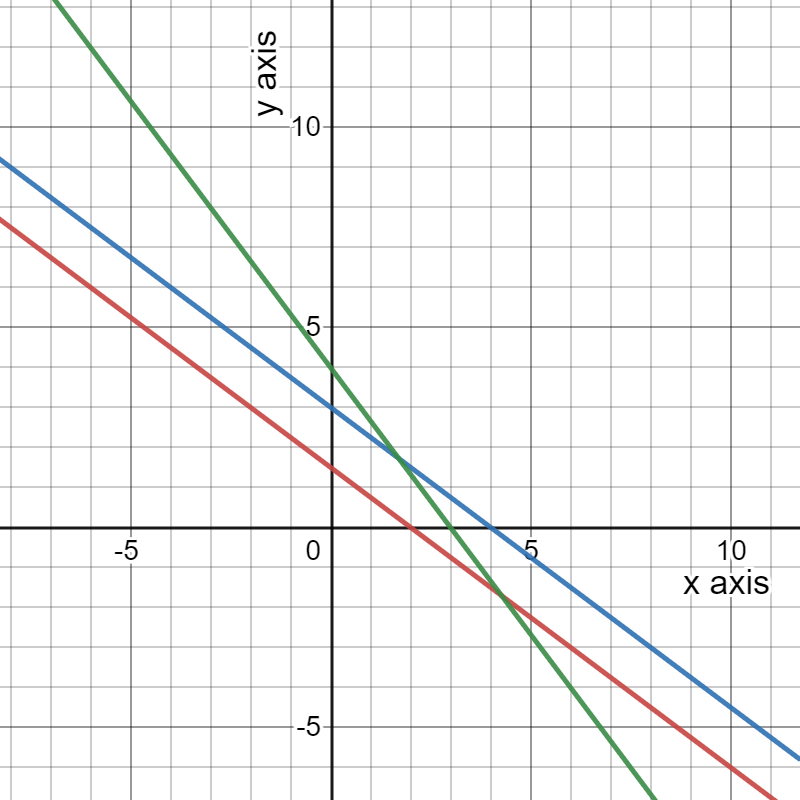
The lines 3x+4y=6 and 3x+4y=12 are parallel
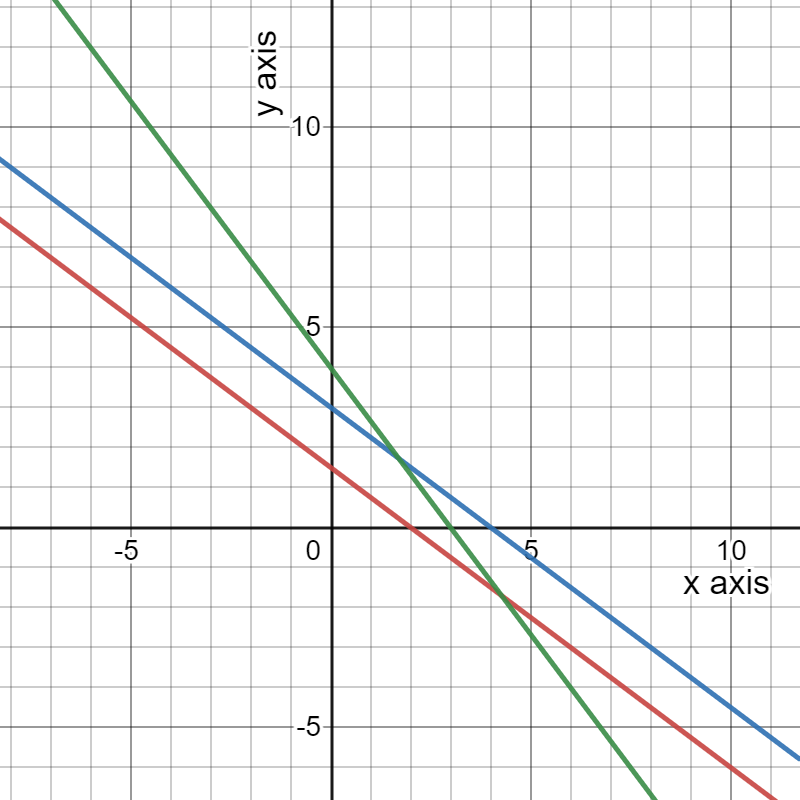
Given: Three lines
To find, the lines that are parallel
We write the equations in slope intercept form, graph the three lines and find the set of lines that doesn’t intersect at any point
We have
Slope intercept form of 5x+2y=6 is y=\(\frac{-5}{2} x+3\)
Slope intercept form of 2x+y=3 is y=−2x+3
Slope intercept form of 2.5x+y=5 is y=−2.5x+5

The lines y\(=\frac{-5}{2} x+3\) (red line) and y=−2.5x+5 (blue line)doesn’t intersect at any point, so they are parallel
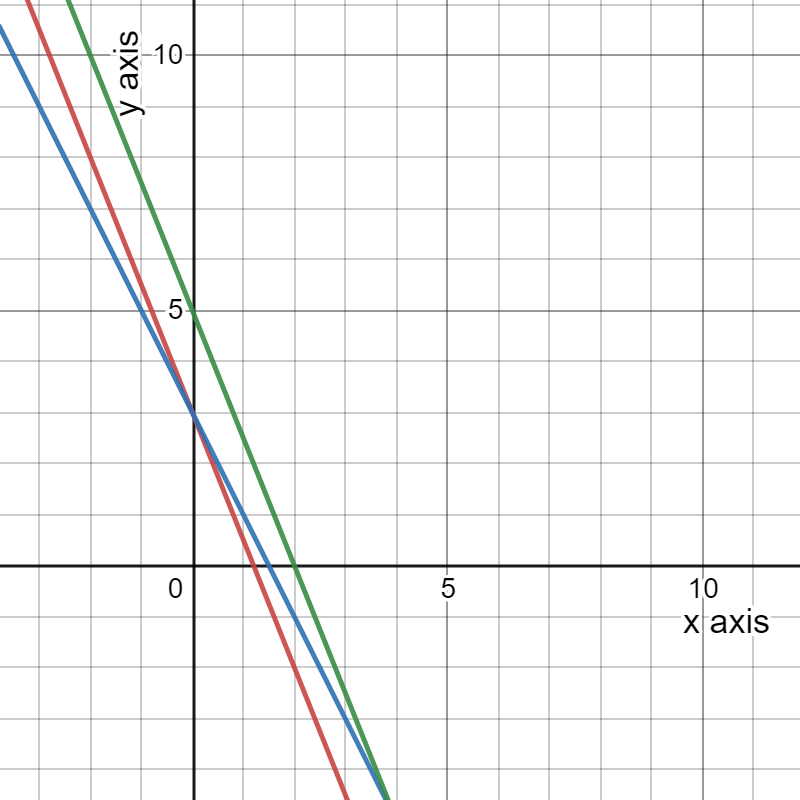
The parallel lines are 5x+2y=6 and 2.5x+y=5

Big Ideas Math Algebra 1 Chapter 4 Exercise 4.3 Solution
Big Ideas Math Algebra 1 Student Journal 1st Edition Chapter 4 Writing Linear Functions Exercise 4.3 Page 107 Exercise 2 Answer
Given: Three lines
To find, the lines that are perpendicular
We rewrite the equations in slope-intercept form and map the equations, then find the lines that intersect at 90°
We have
Slope intercept form of 3x+4y=6 is y\(=\frac{-3}{4} x+\frac{3}{2}\)
Slope intercept form of 3x−4y=12 is y\(=\frac{3}{4} x-3\)
Slope intercept form of 4x−3y=12 is y\(\frac{4}{3} x-4\)
The lines 3x+4y=6 (red line) and 4x−3y=12 (green line) intersect at 90°
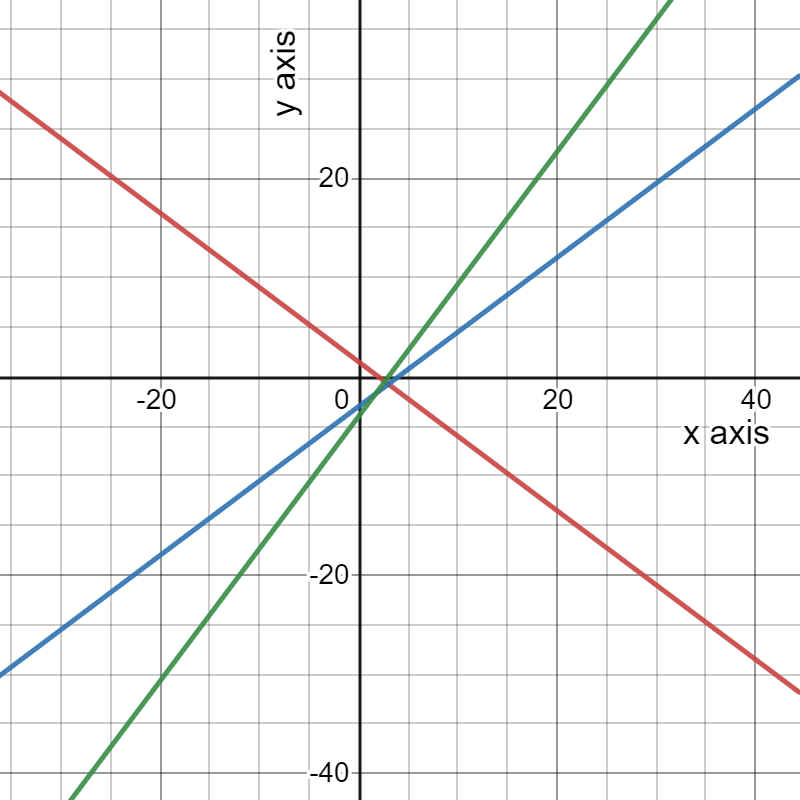
The lines intersecting at 90º are 3x+4y=6 and 4x−3y=12
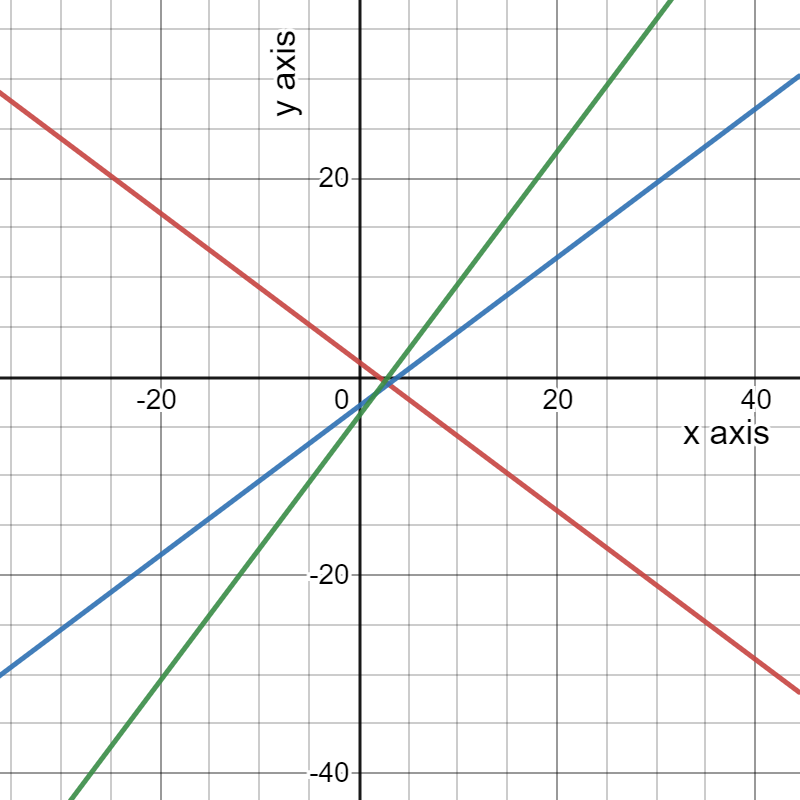
Given: Three equations
2x+5y=10
−2x+y=3
2.5x−y=5.
It is required to write each linear equation in slope-intercept form.
And then use a graphing calculator to graph the three equations in the same square viewing window.
And determine which two lines appear to be perpendicular. Then explain how do we tell which two lines are perpendicular.
To do this, use the graphing calculator TI −84 Plus to plot the graph of these equations.
Consider the given equations.
2x+5y=10
−2x+y=3
2.5x−y=5.
Let’s write each linear equation in slope-intercept form.
2x+5y=10
⇒ 5y=10−2x
⇒ 5y=−2x+10
∴y=\(-\frac{2}{5} x\)+2
−2x+y=3
∴y=2x+3
And
2.5x−y=5
⇒ −y=5−2.5x
⇒ y=−5+2.5x
∴y=2.5x−5.
Let’s graph these slope-intercept form equations by using the graphing calculator Tl−84 Plus. On calculator press Y=, and then enter the expression \(-\frac{2}{5} x\)+2, 2x+3 and 2.5 x-5 in
Y1=,
Y2=,
Y3=.
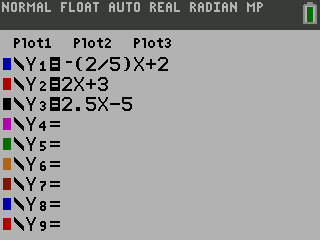
Now, to see its graph press GRAPH key on the calculator.
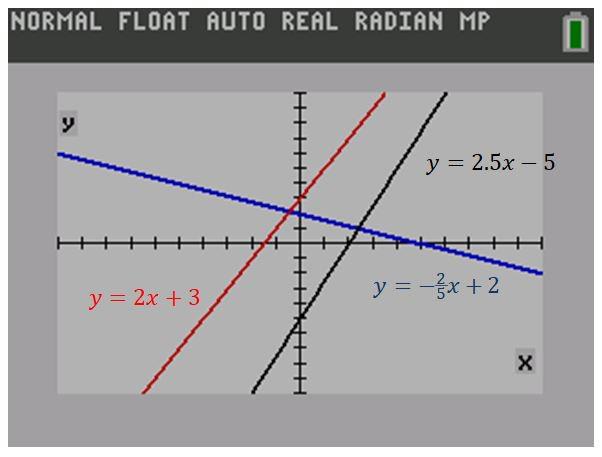
The first line y=\(-\frac{2}{5} x\)+2 and the third line y=2.5x−5 are perpendicular because they intersect at a right angle. And that the slope of the third line is 2.5\(=\frac{5}{2}\)
So, the slopes of the perpendicular lines are negative reciprocals.
The slope-intercept form of the given lines
2x+5y=10
−2x+y=3, and
2.5x−y=5
Are
y\(=-\frac{2}{5} x\)+2
y=2x+3,and
y=2.5x−5 respectively.
And by using a graphing calculator the graph of three equations in the same square viewing window is given below.
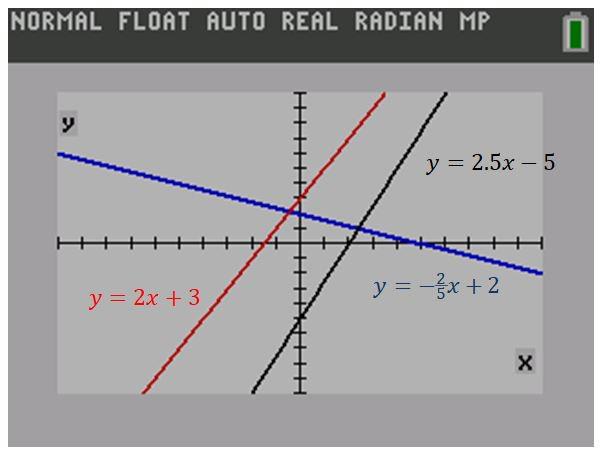
The first line y=\(-\frac{2}{5} x+2\) and the third line y=2.5x−5 are perpendicular because they intersect at a right angle.
Page 107 Exercise 3 Answer
It is required to explain that how we can recognize lines that are parallel or perpendicular.
Before we think about how we can recognize when lines are parallel or perpendicular, let’s look at a graph with an example of each.
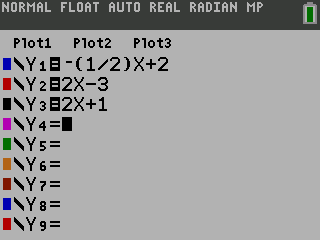
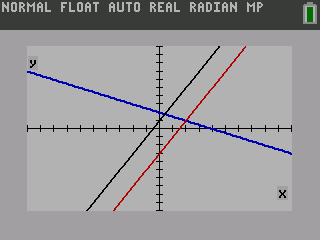
In this example, the red and black lines are parallel and the blue line is perpendicular to both of them.
Visually, we can see that lines are parallel because they will never intersect, they will continue on forever without ever crossing paths.
Algebraically, we can know that lines are parallel because they have the same slope.
y=2x−2
y=2x+1
Similarly, we can tell that lines are perpendicular when looking at them because when they intersect, it is at a perfect 90o angle.
Algebraically, we can know that lines are perpendicular because their slopes are negative reciprocals.
y=2x−2
y=\(-\frac{1}{2} x+2\).
Parallel lines are in the same plane and are always the same distance apart.
Perpendicular lines are in the same plane and intersect at right angles.
Parallel lines have the same slope, perpendicular lines have negative reciprocal slopes.
Writing Linear Functions Exercise 4.3 Big Ideas Math
Big Ideas Math Algebra 1 Student Journal 1st Edition Chapter 4 Writing Linear Functions Exercise 4.3 Page 107 Exercise 5 Answer
It is required to compare the slopes of the lines in Exercise 2.
And explain that how we can use slope to determine whether two lines are parallel.
There were two parts to Exercise 2, let’s look at these individually and then compare our results.
part-1. Consider the given three equations.
3x+4y=6
3x−4y=12
4x−3y=12
And consider their slope-intercept form, from the Exercise 2.
y=\(-\frac{3}{4} x+\frac{3}{2}\)
y=\(\frac{3}{4} x-3\)
y=\(\frac{4}{3} x-4\)
And consider the graph of them on the same coordinate plane.
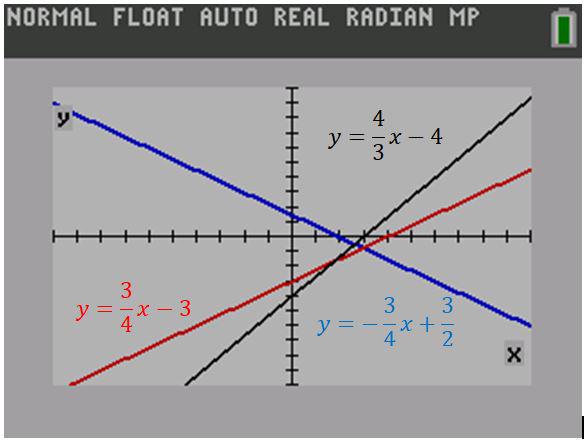
We can see that the perpendicular lines are:
y=\(-\frac{3}{4} x+\frac{3}{2}\)
y=\(\frac{4}{3} x-4\)
The ones represented by the blue and black lines.
Part-2. Consider the given three equations.
2x+5y=10
−2x+y=3
2.5x−y=5
And consider their slope-intercept form, from the Exercise 2.
y\(=-\frac{2}{5} x+2\)
y=2x+3
y=2.5x−5
And consider the graph of them on the same coordinate plane.
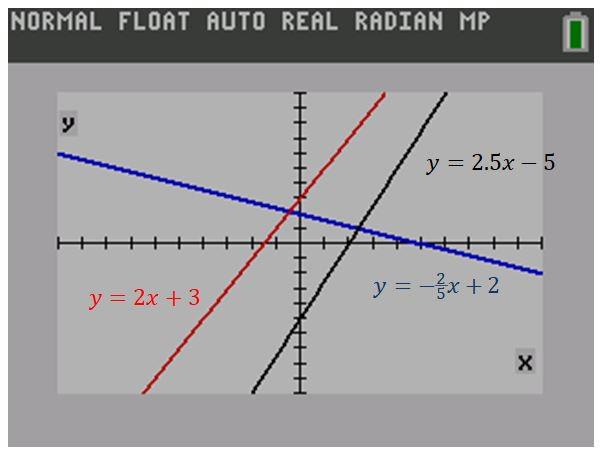
We can see that the perpendicular lines are:
y\(=-\frac{2}{5} x+2\) and
y=2.5x−5
The ones represented by the blue and black lines.
In part-1. The perpendicular lines were:
\(=-\frac{3}{4} x+\frac{3}{2}\) and
y=\(\frac{4}{3} x-4\)
In part-2. The perpendicular lines were:
\(-\frac{2}{5} x+2\)
y=2.5x−5
The perpendicular lines in Exercise 2 have slopes that are reciprocals of each other and have opposite signs.
In part 1. Slope is \(-\frac{3}{4} \text { and } \frac{4}{3} \text {. }\)
In part 2. Slope is \(-\frac{2}{5} \text { and } 2.5=\frac{5}{2} \text {. }\)
When two lines have slopes that are negative reciprocals, the lines will always be perpendicular.
The perpendicular lines in Exercise 2 have slopes that are reciprocals of each other and have opposite signs.
In part 1. Slope is \(-\frac{3}{4} \text { and } \frac{4}{3} \text {. }\)
In part 2. Slope is \(2.5=\frac{5}{2} \text {. }\)
When two lines have slopes that are negative reciprocals, the lines will always be perpendicular.
Big Ideas Math Algebra 1 Student Journal 1st Edition Chapter 4 Writing Linear Functions Exercise 4.3 Page 109 Exercise 1 Answer
Given, a graph:
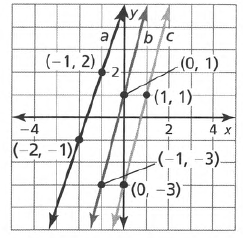
It is required to determine which of the lines are parallel.
To do this, calculate their slopes using the Slope Formula. And if their slopes are identical then lines are parallel.
Two lines are parallel if their slopes are identical.
Thus, we have to calculate their slopes using the Slope Formula.
m\(=\frac{y_2-y_1}{x_2-x_1}\)
Let’s identify the slope of each line.
Line a:
Substitute(x1,y1)=(−1,2) and (x2 ,y2)=(−2,−1)
Into the slope formula.
m\(=\frac{y_2-y_1}{x_2-x_1}\)
m=3
Line b:
Substitute (x1,y1)=(0,1)and (x2,y2)=(−1,−3)
Into the slope formula.
m\(=\frac{y_2-y_1}{x_2-x_1}\)
m\(=\frac{-3-1}{-1-0}\)
m=\(\frac{-3-1}{-1-0}\)
m=4
Lines b and c have the same slope. So, they are parallel.
Lines b and c have the same slope. And they are parallel.
Algebra 1 Student Journal Chapter 4 Exercise 4.3 Answers
Big Ideas Math Algebra 1 Student Journal 1st Edition Chapter 4 Writing Linear Functions Exercise 4.3 Page 109 Exercise 2 Answer
Given, a graph :
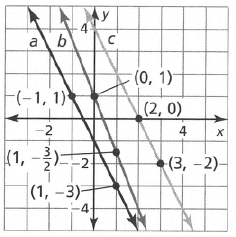
It is required to determine which of the lines are parallel.
To do this, calculate their slopes using the Slope Formula. And if their slopes are identical then lines are parallel.
Two lines are parallel if their slopes are identical. Thus, we have to calculate their slopes using the Slope Formula.
m\(=\frac{y_2-y_1}{x_2-x_1}\)
Let’s identify the slope of each line.
Line a:
Substitute (x1,y1)=(−1,1) and (x2,y2)=(1,−3)
Into the slope formula.
m\(=\frac{y_2-y_1}{x_2-x_1}\)
m\(=\frac{-3-1}{1-(-1)}\)
\(\frac{-4}{2}\)m=-2
Line b:
Substitute (x1,y1)=(0,1)and(x2,y2)=(1,−3/2)
Into the slope formula.
m\(\frac{y_2-y_1}{x_2-x_1}\)
m=\(\frac{-3 / 2-1}{1-0}\)
m=\(\frac{-5}{2}\)
m=-\(\frac{5}{2}\)
And line c:
substitute (x1,y1)=(2,0)and (x2,y2)=(3,−2)
Into the slope formula.
m\(\frac{y_2-y_1}{x_2-x_1}\)
m=\(\frac{-2-0}{3-2}\)
m=\(\frac{-2}{1}\)
m=-2
Lines a and c have the same slope, they are parallel
Lines a and c have the same slope. And they are parallel.
Page 109 Exercise 3 Answer
Given, Line a passes through (−4,−1) and (2,2).
Line b passes through (−5,−3) and (5,1).
Line c passes through (−2,−3) and (2,−1).
It is required to determine which of the lines are parallel. To do this, calculate their slopes using the Slope Formula. And if their slopes are identical then lines are parallel.
Two lines are parallel if their slopes are identical.
Thus, we have to calculate their slopes using the Slope Formula.
m\(=\frac{y_2-y_1}{x_2-x_1}\)
Let’s identify the slope of each line.
Line a:
Substitute (x1,y1 )=(−4,−1) and (x2,y2 )=(2,2)
Into the slope formula.
\(=\frac{y_2-y_1}{x_2-x_1}\)
m\(\frac{2-(-1)}{2-(-4)}\)
m\(=\frac{3}{6}\)
m\(=\frac{1}{2}\)
Line b:
Substitute (x1 ,y1 )=(−5,−3) and (x2,y2 )=(5,1)
Into the slope formula.
m\(=\frac{y_2-y_1}{x_2-x_1}\)
m=\(\frac{1-(-3)}{5-(-5)}\)
m=\(\)
m=\(\frac{2}{5}\)
And line c:
Substitute (x1,y1)=(−2,−3)and (x2,y2 )=(2,−1)
Into the slope formula.
m\(=\frac{y_2-y_1}{x_2-x_1}\)
m=\(\frac{-1-(-3)}{2-(-2)}\)
m\(=\frac{2}{4}\)
m\(=\frac{1}{2}\)
Lines a and c have the same slope. So, they are parallel.
Lines a and c have the same slope. And they are parallel.
Big Ideas Math Algebra 1 Student Journal 1st Edition Chapter 4 Writing Linear Functions Exercise 4.3 Page 109 Exercise 4 Answer
Given, Line a passes through (−2,5) and (2,1
Line b passes through (−4,3) and (3,4).
Line c passes through (−3,4) and (2,−6).
It is required to determine which of the lines are parallel.
To do this, calculate their slopes using the Slope Formula. And if their slopes are identical then lines are parallel.
Two lines are parallel if their slopes are identical.
Thus, we have to calculate their slopes using the Slope Formula.
m\(=\frac{y_2-y_1}{x_2-x_1}\)
Let’s identify the slope of each line.
Line a:
Substitute (x1,y1)=(−2,5)and (x2,y2)=(2,1)
Into the slope formula.
m\(=\frac{y_2-y_1}{x_2-x_1}\)
m=\(\frac{1-5}{2-(-2)}\)
m=\(\frac{-4}{4}\)
m=−1
Line b:
Substitute (x1,y1)=(−4,3)and (x2,y2)=(3,4)into the slope formula.
m\(=\frac{y_2-y_1}{x_2-x_1}\)
m=\(\frac{4-3}{3-(-4)}\)
m=\(\frac{1}{7}\)
And line c:
Substitute (x1,y1)=(−3,4)and (x2,y2)=(2,−6) into the slope formula.
m\(=\frac{y_2-y_1}{x_2-x_1}\)
m= \(\frac{-6-4}{2-(-3)}\)
m=\(\frac{-10}{5}\)
m=−2
Because none of the lines have the same slope, none are parallel.
None of the lines have the same slope, so none of them are parallel.
Big Ideas Math Writing Linear Functions Exercise 4.3 Help
Big Ideas Math Algebra 1 Student Journal 1st Edition Chapter 4 Writing Linear Functions Exercise 4.3 Page 109 Exercise 5 Answer
Given:
Line a: 4x=−3y+9
Line b: 8y=−6x+16
Line c: 4y=−3x+9
It is required to determine which of the lines are parallel.
To do this, write them in the slope-intercept form of a line. Then identify the slope of the lines.
And if their slopes are identical then lines are parallel.
Two lines are parallel if their slopes are identical.
Let’s recall the slope-intercept form of a line.
y=mx+b
Here, we can identify the slope of the line as the value of m.
We will rewrite each equation in this form and find their slopes.
Line a: 4x=−3y+9
⇒ 4x=−3y+9
⇒ −3y+9=4x
⇒ −3y=4x−9
∴y=\(-\frac{4}{3} x\)+3
Line a has a slope of \(-\frac{4}{3} x\)[/latex].
Rewrite other equations in slope-intercept form and find their slopes.
Line b: 8y=−6x+16
8y=−6x+16
⇒ y=\(\frac{-6 x+16}{8}\)
∴y\(=-\frac{3}{4} x+2\)
Line b has a slope of \(=-\frac{3}{4} \)
And line c: 4y=−3x+9
⇒ 4y=−3x+9
⇒ y=−3x+9
⇒ y \(\frac{-3 x+9}{4}\)
∴ y= \(-\frac{3}{4} x+\frac{9}{4}\)
Line c has a slope of \(-\frac{3}{4}\).
Because lines b and c have the same slope, they are parallel.
Lines b and c have the same slope, and they are parallel.
Page 109 Exercise 6 Answer
Given:
Line a: 5y−x=4
Line b: 5y=x+7
Linec: 5y−2x=5
It is required to determine which of the lines are parallel.
To do this, write them in the slope-intercept form of a line. Then identify the slope of the lines.
And if their slopes are identical then lines are parallel.
Two lines are parallel if their slopes are identical.
Let’s recall the slope-intercept form of a line.
y=mx+b
Here, we can identify the slope of the line as the value of m.
We will rewrite each equation in this form and find their slopes.
Line a: 5y−x=4
⇒ 5y−x=4
⇒ 5y=x+4
∴y=\(\frac{1}{5} x+\frac{4}{5}\)
Line a has a slope of \(\frac{1}{5}\).
Rewrite other equations in slope-intercept form and find their slopes.
Line b: 5y=x+7
⇒ 5y=x+7
∴y=\(\frac{1}{5} x+\frac{7}{5}\)
Line b has slope of \(\frac{1}{5}\).
And line c: 5y−2x=5
⇒ 5y−2x=5
⇒ 5y=2x+5
∴y=\(\frac{2}{5} x+1\)
Line c has slope of \(\frac{2}{5}\)
Because lines a and b have the same slope, they are parallel.
Lines a and Line b have the same slope, and they are parallel.
Big Ideas Math Algebra 1 Student Journal 1st Edition Chapter 4 Writing Linear Functions Exercise 4.3 Page 109 Exercise 7 Answer
Given, a line that passes through the (3,−1) and is parallel to the line y\(=\frac{1}{3} x-3\)
It is required to write the equation of a line parallel to the given equation that passes through the point (3,−1).
To do this, use the definition of parallel lines and slope-intercept form.
When lines are parallel, they have the same slope.
Consider the given line, which is written in slope-intercept form.
y\(=\frac{1}{3} x-3\)
And Slope-Intercept Form: y=mx+b
In the given equation we can see that the slope of the line is m\(=\frac{1}{3}\)
Therefore, all the lines that are parallel to the given one have a slope of \(=\frac{1}{3}\)
We can write a general equation in slope-intercept form for all lines parallel to the given equation.\(=\frac{1}{3} x+b\)
We are asked to write the equation of a line parallel to the given equation that passes through the point (3,−1).
By substituting this point into the above equation for x and y, we will be able to solve for the y−intercept b of the parallel line.
y=\(\frac{1}{3} x+b\)
⇒−1\(=\frac{1}{3}(3)+b\)
⇒-1=1+b
∴b=−2
Now that we know that b=−2, we can write the equation of the line that is parallel to y\(=\frac{1}{3} x-3\) and passes through the point (3,−1).
y\(=\frac{1}{3} x-2\)
The equation of the line that is parallel to y\(=\frac{1}{3} x-3\) and passes through the point (3,−1) is
y\(=\frac{1}{3} x-2\).
Page 109 Exercise 8 Answer
Given: Point(1,−2) and, equation of a line y=−2x+1.
Hence, We have to find an equation of the line that passes through the given point and is parallel to the given line.
Firstly, We will find the slope of a given line by using the slope-intercept form that is,y=mx+c.
Then, We will use the point-slope form to get the equation of the line.
That is \(m=\frac{y-y_1}{x-x_1}\)
Where m is a slope of a line. x,y is the point.
From the given line equation that is,
y=−2x+1
On comparing with slope-intercept form y=mx+c
We get,m=−2=m1
We know the two parallel lines have the same slope. That is,m1 =m2 =−2
Where, m2 is the slope of a line whose point is(1,−2).
From the given point(1,−2).
And, slope m2 =−2 from the above step
By using the point-slope formula we get
m=m2=\(\frac{y-y_1}{x-x_1}\)
-2\(=\frac{y-(-2)}{x-1}\)
2x+y=0
An equation of the line that passes through the given point and is parallel to the given line is 2x+y=0.
Exercise 4.3 Big Ideas Math Algebra 1 Guide
Big Ideas Math Algebra 1 Student Journal 1st Edition Chapter 4 Writing Linear Functions Exercise 4.3 Page 110 Exercise 10 Answer
Given:
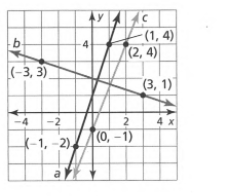
Hene, We have to determine which of the lines, if any, are parallel or perpendicular.
Firstly, We will observe the graph carefully.
We will find the slope of each line by using two point-slope formula that is
\(\frac{y_2-y_1}{x_2-x_1}=\frac{y-y_1}{x-x_1}\)
After that, we compare each line whether they are parallel,m1 =m2 or perpendicular,m1 ×m2=−1.
From the given graph
For line a: (−1,−2),(1,4).
By using the two-point slope formula\(\frac{y_2-y_1}{x_2-x_1}=\frac{y-y_1}{x-x_1}\)
Where,x1 =−1,x2 =1,y1 =−2,y2 =4.
On putting the values in the two-point slope formula we get,
\(\frac{4-(-2)}{1-(-1)}=\frac{y-(-2)}{x-(-1)}\)
y=3x+1
On putting the values in the two-point slope formula y=mx+c,
we get m=3.
For Line b: (−3,3),(3,1).
By using the two-point slope formula \(\frac{y_2-y_1}{x_2-x_1}=\frac{y-y_1}{x-x_1}\)
Where,x1 =−3, x2 =3, y1 =3, y2 =1.
On putting the values in the two-point slope formula we get,
\(\frac{1-3}{3-(-3)}=\frac{y-3}{x-(-3)}\)
y\(=\frac{-1}{3} x+2\)
On putting the values in the two-point slope formula y=mx+c,
We get m\(=\frac{-1}{3}\)
For Line c: (0,−1),(2,4).
By using the two-point slope formula \(\frac{y_2-y_1}{x_2-x_1}=\frac{y-y_1}{x-x_1}\)
Where,x1 =0,x2 =2,y1 =−1,y2 =4.
On putting the values in the two-point slope formula we get,
\(\frac{4-(-1)}{2-0}=\frac{y-(-1)}{x-0}\)
y\(=\frac{3}{2} x-1\)
On putting the values in the two-point slope formula y=mx+c,
We get y\(=\frac{3}{2}\).
Therefore, From the above steps and graph, we conclude that Line a is perpendicular to the line b.
The slope of the line a=3 and the slope of the line b \(=\frac{-1}{3}\).
As it satisfies the condition of the perpendicular lines that is m1×m2=−1,
\(3 \times \frac{-1}{3}\)=-1
−1=−1
Hence, the left-hand side is equal to the right-hand side.
The line a is perpendicular to the line b. As it satisfies the condition of the perpendicular lines.
Page 110 Exercise 12 Answer
Given:
Line a passes through(−2,−4),(−1,−1).
Line b passes through(−1,−4),(1,2).
Line c passes through(2,3),(4,2).
Hene, We have to determine which of the lines, if any, are parallel or perpendicular.
Firstly, We will find the slope of each line by using two point-slope formula that is\(\frac{y_2-y_1}{x_2-x_1}=\frac{y-y_1}{x-x_1}\).
After that, we compare each line whether they are parallel,m1 =m2, and perpendicular,m1×m2=−1.
Line a: From the points(−2,−4),(−1,−1) of
By using the two-point slope formula \(\frac{y_2-y_1}{x_2-x_1}=\frac{y-y_1}{x-x_1}\)
Where,x1=−2, x2 =−1, y1 =−4, y2 =−1.
On putting the values in the two-point slope formula we get
\(\frac{-1-(-4)}{-1-(-2)}=\frac{y-(-4)}{x-(-2)}\)y=3x+2
On comparing with the slope-intercept form y=mx+c
We get m=3.
Line b: For points(−1,−4),(1,2) of
By using the two-point slope formula \(\frac{y_2-y_1}{x_2-x_1}=\frac{y-y_1}{x-x_1}\)
Where,x1 =−1, x2 =1, y1 =−4, y2 =2.
On putting the values in the two-point slope formula we get
\(\frac{2-(-4)}{1-(-1)}=\frac{y-(-4)}{x-(-1)}\)y=3x−1
On comparing with the slope-intercept form y=mx+c,
We get m=3.
Line c: For points(2,3),(4,2) of
By using the two-point slope formula \(\frac{y_2-y_1}{x_2-x_1}=\frac{y-y_1}{x-x_1}\)
Where,x1 =2, x2 =4, y1 =3, y2 =2.
On putting the values in the two-point slope formula we get
\(\frac{2-3}{4-2}=\frac{y-3}{x-2}\) \(y=\frac{-1}{2} x+4\)On comparing with the slope-intercept form y=mx+c
We get,m\(=\frac{-1}{2}\).
Therefore, From the above steps, we conclude that
Line a is parallel to the line b.
As the slope of the line a equal to the slope of the line b
That is m=3.
The line a is parallel to line b. And, the Slope of line a= slope of the line b=3.
Page 110 Exercise 13 Answer
Given:
Line a: y\(=\frac{3}{4} x+1\)
Line b: −3y=4x−3
Line c: 4y=−3x+9
Hene, We have to determine which of the lines, if any, are parallel or perpendicular.
Firstly, We will find the slope of each line, by comparing each line with the slope-intercept form y=mx+c.
After that, we compare each line whether they are parallel,m1 =m2, and perpendicular,m1×m2 =−1.
From the equation of the line a:
y=\(\frac{3}{4} x+1\)
On comparing with the slope-intercept form y=mx+c
We get,m\(=\frac{3}{4}\)
From the equation of the line b: −3y=4x−3
y\(=\frac{-4}{3} x+1\)
On comparing with the slope-intercept form
We get,m=-\(\frac{-4}{3}\)
From the equation of the line c: 4y=−3x+9
y\(=\frac{-3}{4} x+\frac{9}{4}\)
On comparing with the slope-intercept form
We get,m\(=\frac{-3}{4}\).
Therefore, From the above step, we conclude that Line a is perpendicular to the line b.
Slope of line a=\(\frac{3}{4}\) and line b=−\(\frac{4}{3}\)
As it satisfies the condition of the perpendicular lines that is m1×m2 =−1
\(\frac{3}{4} \times \frac{-4}{3}\)=-1
−1=−1
Hence, the left-hand side is equal to the right-hand side.
The linea is perpendicular to the line b. As it satisfies the condition of the perpendicular lines.
Big Ideas Math Chapter 4 Exercise 4.3 Walkthrough
Big Ideas Math Algebra 1 Student Journal 1st Edition Chapter 4 Writing Linear Functions Exercise 4.3 Page 110 Exercise 14 Answer
Given:
Line a: 5y−2x=1
Line b: y\(=\frac{5}{2} x-1\)
Line c: y\(=\frac{2}{5} x+3\).
Hene, We have to determine which of the lines, if any, are parallel or perpendicular.
Firstly, We will find the slope of each line, by comparing each line with the slope-intercept form y=mx+c.
After that, we compare each line whether they are parallel,m2 =m2, and perpendicular,m1×m2 =−1.
From the equation of the line a: 5y−2x=1
y\(=\frac{2}{5} x+1\)
On comparing with the slope-intercept form y=mx+c
We get,m\(=\frac{2}{5}\)
From the equation of the line b: y\(=\frac{5}{2} x-1\)
On comparing with the slope-intercept form
We get,m=\(\frac{5}{2}\).
From the equation of the line c: y\(=\frac{2}{5} x+3\)
On comparing with the slope-intercept form
We get,m\(=\frac{2}{5}\)
Therefore, From the above step, we conclude that Line a
is parallel to the line c.
As the slope of lines a,c\(=\frac{2}{5}\)
Line a is parallel to the line c And, the slope of the line a= the slope of the line c\(=\frac{2}{5}\)
Page 110 Exercise 15 Answer
Given: Point(−2,2) and equation of the line y\(=\frac{2}{3} x+2\)
Hence, We have to find an equation of the line that passes through the given point and is perpendicular to the given line.
Firstly, We will find the slope of a given line by using the slope-intercept form that is,y=mx+c.
Then, We will use the point-slope formula to get the equation of the line.
That is,m\(=\frac{y-y_1}{x-x_1}\)
Where m is the slope of a line. x,y is a point.
From the given line equation that is\(y=\frac{2}{3} x+2\)
On comparing with slope-intercept form y=mx+c,
We get,m\(=\frac{2}{3}\)=m1.
We know the two perpendicular lines have m1 ×m2=−1
Where,m1=\(\frac{2}{3}\) from above.
Therefore,\(\frac{2}{3}\)×m2=−1
m2\(=\frac{-3}{2}\)
Where m2 is the slope of a line whose point is(−2,2).
From the given point(−2,2).
And,slope,m2=\(\frac{-3}{2}\) from the above step.
By using the point-slope formula we get
3x+2y=−2
An equation of the line that passes through the given point and is perpendicular to the given line 3x+2y=−2.
Big Ideas Math Algebra 1 Student Journal 1st Edition Chapter 4 Writing Linear Functions Exercise 4.3 Page 110 Exercise 16 Answer
Given: Point(3,1) and, equation os a line 2y=4x−3.
Hence, We have to find an equation of the line that passes through the given point and is perpendicular to the given line.
Firstly, We will find the slope of a given line by using the slope-intercept form that is,y=mx+c.
Then, We will use the point-slope formula to get the equation of the line.
That is,m\(=\frac{y-y_1}{x-x_1}\)
Where m is the slope of a line. x,y is a point.
From the given line equation that is,
2y=4x−3
y=2x−\(\frac{3}{2}\)
On comparing with slope-intercept form y=mx+c
We get m=2=m1.
We know the two perpendicular lines have m1×m2=−1
where m1 =2 from above.
Therefore,2×m2=−1
m2\(=\frac{-1}{2}\)
Where m2 is the slope of a line whose point is(3,1).
From the given point(3,1).
And,slope,m 2\(\frac{-1}{2}\) from the above step.
By using the point-slope formula we get
m2\(=\frac{y-y_1}{x-x_1}\)
\(\frac{-1}{2}=\frac{y-1}{x-3}\)x+2y=5
An equation of the line that passes through the given point and is perpendicular to the given line x+2y=5.
Big Ideas Math Student Journal Exercise 4.3 Examples
